
- Wood From Original
- Item Length
- Material
- Occasion
- Pattern
- Shape
- Size
- 12\ (2)
- 17 X 23cm (3)
- 3.5 X 4 In (2)
- 32 X 13cm (3)
- 36.5 X 24cm (9)
- 53 X 42cm (3)
- 8” (3)
- Assorted (2)
- Full (2)
- Giant (over 60in.) (6)
- King (3)
- Large (72)
- Large (up To 60in.) (28)
- Medium (135)
- Medium (up To 36in.) (122)
- Mittel (2)
- See Description (2)
- Small (50)
- Small (up To 12in.) (33)
- Standard (2)
- ... (3665)
THE RETURN FROM THE WOODs Original Currier & Ives Medium Folio Lithograph C5131
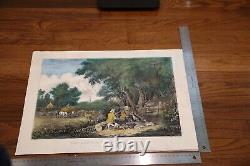
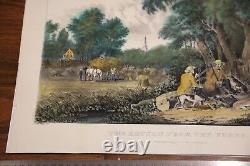
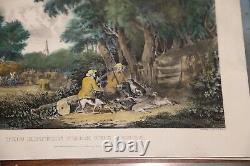
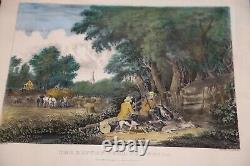
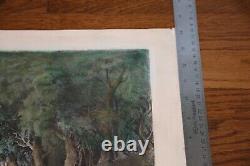
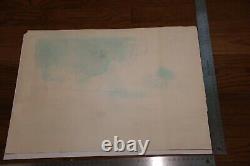


Please look at my other auctions for more early American lithographs by Currier & Ives as well as several others some rare ones listed and coming up as well. TITLE: THE RETURN FROM THE WOODS. By Fanny Palmer (Frances Flora Bond).
I utilize a 20.5 by 17 flat ULINE cardboard mailer for the unframed prints that is quite stiff to prevent bending in transit. I put extra support inside the mailer again to prevent bending. Each of the prints is placed in a sleeve with archival paper. Most of these packages weigh around 2 pounds. Lithographs to be listed for sale. Having been a collector of all types of lithographs for over 50 years its time for me to thin down my collection of many, many hundreds of prints by Nathaniel Currier, Currier & Ives, Kellogg, Kellogg & Comstock, Sarony, Major, Knapp, Haskell & Allen, Thomas Kelly, James Baillie, and many others. For the first few weeks I will be listing the minor lithographs in my collection, some of the more important collectible ones will follow in a month or two. I often have multiple examples of the lithographs and have many variants that have not been catalogued in any of the major reference books.The unframed lithographs are photographed on a bright white sheet of archival paper, measuring 14 by 18. Rulers have been placed on 2 sides of the archival paper so that you can evaluate the actual size of the print. History of Currier & Ives.
Nathaniel Currier was apprenticed in 1828 (age 15) to the Boston printing shop of William & John Pendleton. He was taught lithography there by the chief printer a man named Dubois. In 1833, he left the Pendletons operation to move to Philadelphia to work with M E D Brown. In 1834, he left to move to NYC to rejoin John Pendleton, where he formed a partnership with Stodart and bought out Pendleton. The firm was named Currier & Stodart.
This firm performed commercial orders including sheet music. By 1835, they had dissolved their partnership and Currier started his own business N. Currier, Lithographer at 1 Wall Street. Currier started trying out new prints of newsworthy events such as the death of President Harrison in 1841, and disaster such as The Ruins of the Planters Hotel, New Orleans (this is believed to be his first disaster print).
Currier made his name with the disaster print Awful Conflagration of the Steamboat Lexington which as published in the New York Sun. I have several of these and they are quite impressive. By 1852 the business was expanding and Currier hired James Ives as the office manager. Ives was a self-taught artist and brother-in-law of Nathaniels brother Charles.
In 1857, Ives was made a partner and from there on all imprints were Currier & Ives. In 1880, Nathaniel retired and turned the business over to his son, Edward. James Ives remained with the firm until his death in 1895. James Ives son Chauncey took over as the partner. A sad end to an amazing firm.Addresses and approximate dates: useful for dating undated prints. Stodart & Currier 137 Broadway NY 1834-35.
Currier 1 Wall Street NY 1835-36. Currier 148 Nassau St NY 1836-37.Currier 152 Nassau St Cor. Currier 2 Spruce St NY 1838-56.
C&I 152 Nassau St NY 1857-72. C&I 125 Nassau St NY 1872-74. C&I 123 Nassau St NY 1874-77. C&I 115 Nassau St NY 1877-94.
C&I 108 Fulton St NY 1894-96. C&I 33 Spruce St NY 1896-07. Of note Currier utilized 2 floors of 33 Spruce Street from at least 1866 onward but rarely used that address on the prints. I have found prints dating far before 1866 with that address, so I suspect it was used many years earlier by the colorists working for Currier.
Competitors to Currier & Ives. There were multiple lithographers competing with Currier & Ives although none were ever as successful as Currier & Ives.Generally, the competitors had artwork that was somewhat more primitive and the paper stock was usually of a lesser grade. Some of the competitors either trained with or worked for Currier (or Currier worked with them) at one time or another. Daniel Wright Kellogg & Co. 1807 established in 1830 (pre-dating Currier) the firm retained his name until 1842, although after 1836 the work was done by his brothers and other employees. In 1842 the firm was formally taken over by his younger brothers E.
The firm was in Hartford, CT. I find that the DW Kellogg lithographs are generally of much higher quality and printed on better paper than any of the other lithographers.These are all from the 1830s. Edmund Burke & Elijah Chapman Kellogg younger brothers of DW Kellogg. Established in 1842 they operated under this name until 1848 it them became Kellogg & Comstock through 1850. The brothers resumed their partnership in 1855 and continued until the firm became Kellogg & Bulkeley in 1867.
In 1848 the Kelloggs were joined by John C. Comstock but the association was dissolved in 1850. This was the succeeding firm after the EB & EC Kellogg years and was formed in 1867. Famous lithography firm out of Boston with some truly remarkable prints, equally collectible as compared to Currier.
Haskell and Allens most memorable productions were their horse prints. A Boston based publisher of lithographs, the firm seems to have issued more large folio images than small. In 1873, they moved to 61 Hanover St in Boston where they prospered for a few years. They went bankrupt in 1878.
Started by the famous photographer and artist Napoleon Sarony. This firm produced lithographs for the famous Pacific Rail Road Survey of the mid-1850s. Napoleon Sarony (18211896) was born in Quebec and trained under several lithography firms including Currier & Ives and H. Sarony was also known for his successful experiments in early photography, developing his own cabinet-sized camera. In 1846, he partnered with another former apprentice of Nathaniel Currier, Henry B. Major, and the duo created lithography firm of Sarony & Major. Knapp joined the firm in 1857. Sarony, Major & Knapp earned a solid reputation for lithography and the company was especially known for its fine art chromolithography.Sarony departed the business in the mid-1860s to pursue photography fulltime and by the 1870s, the firm shifted it production from decorative prints to the more profitable field of advertising. It expanded to become the conglomerate known as the American Lithographic Company, which produced calendars, advertising cards, and posters. In 1930, it was bought out by Consolidated Graphics. Active in New York from 1838 to 1855.
James Baillie started as a framer in 1838, and then became an artist and lithographer in 1843 or 1844. He discovered how to color lithographs while working as an independent contractor for Currier & Ives in the mid 1840s. A prolific lithographer and colorist for Currier & Ives; his prints were extremely popular with a wide distribution. Baillie spent his later years concentrating on painting instead of lithography. Many of his prints appear to be knockoffs of Currier works. The company went through several iterations and name changes until about 1865.He continued to work in the lithography and publishing business for the remainder of his life. In 1865, his sons Frank and Henry John became partners in Bufford & Sons or J. After his death, they continued the family business as Bufford Brothers and as Bufford Sons Engraving & Lithographing Company until 1911. Some of the large folios of ships are quite striking in my view.
I have owned many Kellys over the years and will list a few here. Thomas Kelly, of New York City, was one of the more successful publishers of the period, creating archetypal and idyllic views of all areas of life in America. Kelly's work is distinctive for strong coloring and vivid, forthright compositions. Not too much detail is known about Kelly but he worked at least in the 1850s in NYC.His works are often more primitive than the others but he does have a few fine pieces. William Endicott (Endicott & Co). Known as one of the leading lithography firms of the mid-19th Century, Endicott and Company was formed in 1852 as the successor to William Endicott and Company following the death of George Endicott in 1848 and William Endicott in 1852.
The original partners of Endicott and Company were Sarah Endicott (Williams widow) and Charles mills. However, in 1853 the senior partner was Sarah and Williams son Frances Endicott. The company often did work for Currier and Ives, and employed the well-known artist Charles Parsons.
In 1856 the company was awarded a diploma for the best specimen of lithography at the 28th Annual Fair of the American Institute. George Cohenour Currier & Ives Lithographs Value Guide its out of print and not always easy to find, and the prices are out of date (2001) but the list is more complete than Conningham.
Frederic Conningham Currier & Ives An Illustrated Check List (this one and Gale are the core of any set of C&I books). Harry Peters America On Stone ; Harry Peters Currier & Ives, Printmakers to the American People.
American Historical Print Collectors Society publication: Imprint ; and Jane Cooper Bland Currier & Ives A Manual for Collectors. For those really interested in old lithographs, consider joining the American Historical Print Collectors Society (can be found on the web). The AHPCS is a good resource and an excellent way to meet fellow collectors. (Note this does not refer to the size of the paper on which the litho was printed but rather the image size). Very Small: up to about 7 by 9.
Small: approximately 8.8 by 12.8. Medium: approximately 9 by 14 to 14 by 20. Large: anything over 14 by 20.
Note that Gale and Conningham occasionally have differences of opinion on what is a small, medium or even a large folio lithograph. Sorting out small versus medium on the vignettes is virtually impossible and I consider many of the determinations by both Gale and Conningham to be arbitrary. Original Sheet Sizes : (Note most prints have been cut down over the years to fit into whatever frame was used so full sheets are quite rare). 30 by 41 (only one title of this size printed). Over the years the firm employed many artists and/or many artists used Currier as an outlet for their freelance work.
I have listed some of the more famous ones below. I have examples of all in my collection. Recall also that Nathaniel Currier and James Ives were artists in their own right.
Outside artists might be employed to do a painting or drawing and might or might not be employed to then re-create this image on stone (as the lithographer). Originally Currier and subsequently Currier & Ives used a quality of paper that was better than many of their peers, with what appears to be a higher rag (cotton fiber) content.As the years progressed I have seen many originals printed on paper of much lesser quality, including some with modest pulp content in the 1880-90s. After making that comment, I will say that very high pulp content papers are not typical of any original Currier & Ives and would make the print immediately suspect in terms of authenticity. As several people have mentioned to me, during the Civil War Currier & Ives frequently used a grade of paper of much lower quality (as cotton linters were scarce) and that is why it is so difficult to obtain Civil War lithographs in decent condition. In general Currier & Ives lithographs were produced by the process of single stone lithography, but some of the more complex lithographs required 3 or more stones, generally each one for a different color.
There are also a number of chromolithographs produced by the firm in the 1890s that are often listed as printed in oils which were done with stones but by an outside firm as C&I was not set up to handle this more modern process. Generally, once you have seen a real C&I you will not be fooled by the run of the mill later copies. I do not accept that philosophy for lithographs that have significant damage, have been improperly stored or will be destroyed over time by acidic or other conditions. So, I believe in restoration and conservation, but only to the extent necessary.The process of restoration and conservation is time consuming and costly and not all lithographs are worth the time or expense. You can infer from this description that the rarest lithographs undergoing conservation will not appear here. If you have an interest in the process I would suggest you look into the publications of the AIC (American Institute for Conservation of Historic & Artistic Works). Conservators rarely discuss their techniques and discourage amateurs from trying to restore old prints.
However, restoration and conservation represent chemistry and physics with a goodly dose of artistic interpretation, and a hefty dose of the proper equipment and training and so there only a few conservators to use. I use Wayne Osterholm as my conservator. Taking care of these lithographs will assure that the next generation has a chance to evaluate the history of our country through the contemporary eyes of these famous artists. I think we owe preservation of these historic documents to our children and our grandchildren. Occasionally I will sell a lithograph framed, but generally my lithographs are unframed, these are placed in a plastic sleeve for protection. For the next several months I plan to list 10+ lithographs per week so I can thin down the mass of prints stored in cabinets. I will try to answer any and all questions posed to me. Generally, I start the lithographs off at a low price, however, there will be a select few that are not in the low-price category. If you notice an error just let me know and I will fix it promptly or remove the litho. You may return this lithograph if you are dissatisfied with the accuracy of my description, or if I failed to disclose pertinent information in either: the description, details, pictures or answers to queries.Thanks for looking and good luck, I hope you are successful in your collecting! The item "THE RETURN FROM THE WOODs Original Currier & Ives Medium Folio Lithograph C5131" is in sale since Saturday, October 10, 2020. This item is in the category "Art\Art Prints". The seller is "jimgacb" and is located in Franklin, Tennessee. This item can be shipped to United States.
- Size: Medium (up to 36in.)
- Artist: Nathaniel Currier
- Style: Americana
- Listed By: Dealer or Reseller
- Printing Technique: Stone Lithograph
- Quantity Type: Multi-Piece Work
- Medium: Lithograph
- Date of Creation: 1850
- Year: ND
- Features: Hand colored
- Width (Inches): 18
- Color: Muli-color
- Subject: Americana
- Originality: Original
- Height (Inches): 14
- Print Surface: Paper

